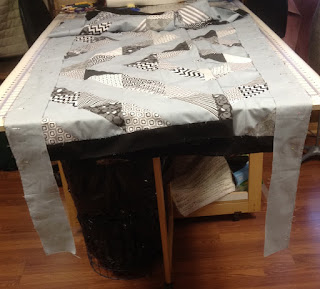(Not what you want to see your quilt doing)
I did something today I have never done before. I decided I would fix a customer quilt
instead of dealing with her errors as I quilted. I am glad I did. The unfortunate part, because it took 3 hours
of my life at no charge, is there is a second quilt exactly like the first and
I have to fix it, too.
I am a quilter. I am
not a fixer of bad seams, a picker of untrimmed threads on the back
side of a quilt and I don’t press for you.
That’s your job when you make your quilt. I just quilt it. I do deal with seams that come apart, and I
whip stitch them together as I find them while quilting. I don’t trim threads,
but can give you advice about how to fish them out of the quilt after the fact
if they annoy you. I spritz the backing with water when I am loading if it is
terribly wrinkled, as I hate having to whip stitch pleats that happen because
of super set in folds of fabric that haven’t been pressed out before I get it.
 |
| Extra fabric from long sides |
I have dealt with some pretty intense ripples in borders that surprised me as I went along in the quilting, and I sure wished I didn’t have to figure out ways to suck up all that extra fabric that shouldn’t be in the border in the first place. I don’t criticize anyone for technique. We all learn things somewhere. I deal with it. It’s my job.
 |
| Extra fabric from borders of Quilt #1 |
When I took these two quilts in, I could see the extra - large borders and I talked with the piecer about how that happened. She asked me how to keep that from happening again. I suspected she did not pin her borders onto her top and she said she hadn’t. She had used straight of grain fabric for the two borders, but she said as she sewed them on they just got longer and longer. She does not have a big table like I have that would make pinning so easy. She watched videos on the internet to learn all she did learn about making a quilt top.
 |
| Before fix of Quilt #2 |
I told her I would deal with them as I quilted. My usual way is to take tucks and whip stitch them down after I am done quilting. She said the last quilter had to do that, too.
The alarm bells were ringing pretty loud in my head over how
big these two quilts smiled at me. Today
I took a second look. I had said I could
quilt them, so I had two choices. I
could quilt and deal with tucks, or I could take the borders off and put them
back on by PINNING. I chose the lesser of two evils. As I thought about those two quilts all day
today I kept thinking about how the ones I have had surprise me as I quilted
surprised me because I did not SEE the extra fabric in the borders as I was
checking in the quilt with the owner standing on the other side of the
table. All rippled borders I have dealt
with in the past have shown up beyond half way along in the quilting. These two
quilts weren’t surprising me; they announced right up front they had issues.
Studying the blocks after the borders were off, I figured out why the problem happened in the
first place. She used a technique to
make half square triangles that probably involved sewing all four sides of pairs
of big squares and cutting them on the diagonal twice. This is an easy way to make half square
triangles, but it makes the straight edges of each triangle be on the bias and
you have to handle your quilt top with care to keep it from stretching out of
control in any subsequent steps in the quilt making process. When she held the
borders in her hand and just sewed them to the top, those bias edges were out
of control.



No comments:
Post a Comment